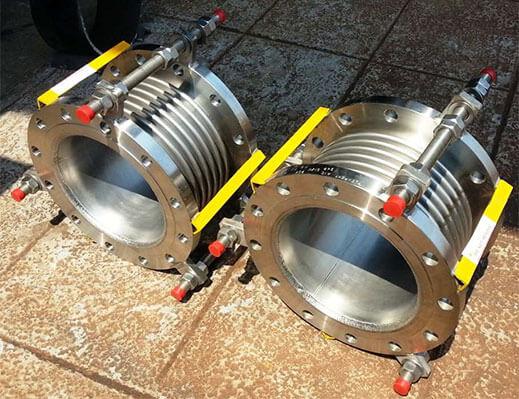Pipe expansion Joints or bellows are the most crucial element of our piping system, and it is very commonly used in the industry sectors where thermal expansions are used. Mainly, bellows or joints are utilized to check and balance the gaps in the piping system caused by thermal expansion, dimensional changes, or pressure and misalignment during installation.
However, everyone who knows the worth of bellows still needs clarification about which bellows to use, metallic or non-metallic. No Worries, we will make it simple for you. We will tell you the difference so that you can choose the ideal solution for your application. So, let's get started:
What are Metal bellows?
Metal bellows are elastic vessels that can be contracted or extended when pressure is applied to the vessel's exterior. When the pressure or vacuum is removed, the bellows return to their original shape (assuming the material has not been stretched beyond its yield capacity).
Metal bellows are classified into two types: formed and welded. Formed bellows are made by reworking tubes, generally made by deep drawing, using several procedures such as cold forming (rolling), electroforming, and hydroforming.
The cost and performance of the two bellows kinds are frequently compared. Hydroformed bellows have a high manufacturing cost but may have a cheaper component cost when produced in large numbers.
However, due to their comparatively thick walls and high rigidity, hydroformed bellows have inferior performance characteristics. Welded metal bellows provide a cheaper initial tooling cost and superior performance characteristics.
Metal bellows can be used in various applications, including actuators, beamlines, expansion joints, thermal expansion tanks, reservoirs, mechanical seals, pumps, valve seals, etc.
Engine exhaust bellows, Lateral Expansion Joints, Externally Pressurized Expansion Joints, and pipe expansion joints are a few examples of metal bellows.
What are Non-metallic bellows?
"Non-metallic/Fabric Expansion Joints and bellows are flexible plugs designed to relieve stress in ducting systems by absorbing thermal movement." They also serve as vibration isolators, shock absorbers, and, in some cases, to compensate for minor misalignment of adjacent ducting or equipment." Fabric Expansion bellows usually are built for ducts with known pressures of up to 3 psi (2000 mm w/c) and temperatures of up to 1000oC. Nevertheless, at higher temperatures, the duct must be internally heated.
Rubber bellows are an important product used for hydraulic ram protection, fluid filling systems, chemical plants, vibrating arrangements, and to compensate for misalignments in the duct line.
Also Read: Advantages of Metal Bellows Expansion Joints
Differences between Metal and Non-metallic Expansion Bellows
Everything in this world comes with advantages and disadvantages, good and bad. With the help of a few points, we have tried to explain the key distinctions between Metal and Non-metallic bellows:
- Non-metallic expansion bellows compensate far more than High-temperature stainless steel bellows do at the same size circumstances, particularly for lateral displacement compensation.
- The expansion bellows function similarly to an elastic body that can offer resistance when compressed or expanded. The metal expansion joint offers more resistance than a non-metallic expansion joint. If this resistance is too high, it will eventually harm adjacent machinery.
- The non-metallic expansion joint's material performs well at high temperatures and far better against acids and alkalis. At 600 °C, the yield limit of structural steel with typical carbon equals zero. The steel surface will rust and peel if the temperature rises.
- Thermal insulation is a property of the non-metallic expansion joint's construction. The metal bellows, however, lacks that since it has an insulating layer covering its outside surface, which helps to maintain heat.
- The regular service life cycle of non-metallic expansion bellows does not require maintenance. Especially for big sizes, non-metallic expansion bellows are significantly more straightforward to replace than metal ones. This is so they may be assembled before being lifted to the installation place for the metal bellows. Large lifting equipment is required for this. The non-metallic expansion joint, however, may be put together right there, where it will be installed. The cloth components may be wrapped up without removing the metal frame if replacement is necessary.
- Non-metallic expansion bellows are often suitable with gas compared to metal expansion bellows. Rubber expansion bellows can work with both liquid and gas as their medium. The rubber expansion joint's operating temperature typically ranges between 100 and 110 degrees Celsius.
Conclusion
In a nutshell, both possess significance and capacity to serve, depending on the circumstances. However, if we had to pick one, we would argue that metal bellows are superior to non-metallic ones. Their multi-layered structure facilitates their usage in several applications across various sectors, making them the perfect investment.
We have tried to clear the difference between metallic and non-metallic bellows. If you are considering purchasing joint bellows for your piping system, then Flexpert Bellows could be your ideal destination.
They are India's leading expansion joint manufacturer that offers top-notch metallic and non-metallic bellows customized for your applications at affordable and reasonable rates.


